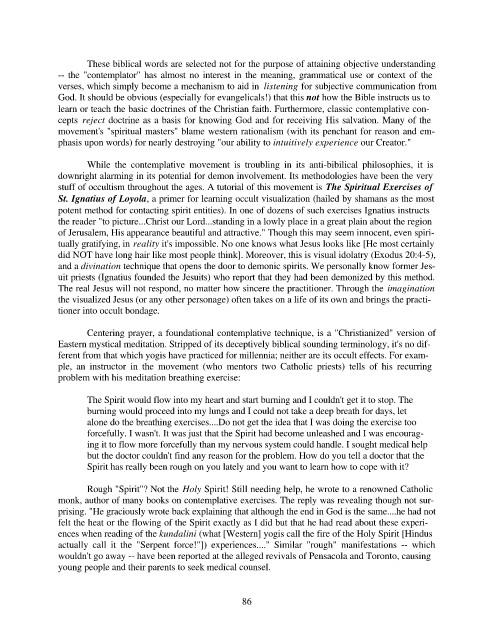Page 86 - BV3
P. 86
These biblical words are selected not for the purpose of attaining objective understanding
-- the "contemplator" has almost no interest in the meaning, grammatical use or context of the
verses, which simply become a mechanism to aid in listening for subjective communication from
God. It should be obvious (especially for evangelicals!) that this not how the Bible instructs us to
learn or teach the basic doctrines of the Christian faith. Furthermore, classic contemplative con-
cepts reject doctrine as a basis for knowing God and for receiving His salvation. Many of the
movement's "spiritual masters" blame western rationalism (with its penchant for reason and em-
phasis upon words) for nearly destroying "our ability to intuitively experience our Creator."
While the contemplative movement is troubling in its anti-bibilical philosophies, it is
downright alarming in its potential for demon involvement. Its methodologies have been the very
stuff of occultism throughout the ages. A tutorial of this movement is The Spiritual Exercises of
St. Ignatius of Loyola, a primer for learning occult visualization (hailed by shamans as the most
potent method for contacting spirit entities). In one of dozens of such exercises Ignatius instructs
the reader "to picture...Christ our Lord...standing in a lowly place in a great plain about the region
of Jerusalem, His appearance beautiful and attractive." Though this may seem innocent, even spiri-
tually gratifying, in reality it's impossible. No one knows what Jesus looks like [He most certainly
did NOT have long hair like most people think]. Moreover, this is visual idolatry (Exodus 20:4-5),
and a divination technique that opens the door to demonic spirits. We personally know former Jes-
uit priests (Ignatius founded the Jesuits) who report that they had been demonized by this method.
The real Jesus will not respond, no matter how sincere the practitioner. Through the imagination
the visualized Jesus (or any other personage) often takes on a life of its own and brings the practi-
tioner into occult bondage.
Centering prayer, a foundational contemplative technique, is a "Christianized" version of
Eastern mystical meditation. Stripped of its deceptively biblical sounding terminology, it's no dif-
ferent from that which yogis have practiced for millennia; neither are its occult effects. For exam-
ple, an instructor in the movement (who mentors two Catholic priests) tells of his recurring
problem with his meditation breathing exercise:
The Spirit would flow into my heart and start burning and I couldn't get it to stop. The
burning would proceed into my lungs and I could not take a deep breath for days, let
alone do the breathing exercises....Do not get the idea that I was doing the exercise too
forcefully. I wasn't. It was just that the Spirit had become unleashed and I was encourag-
ing it to flow more forcefully than my nervous system could handle. I sought medical help
but the doctor couldn't find any reason for the problem. How do you tell a doctor that the
Spirit has really been rough on you lately and you want to learn how to cope with it?
Rough "Spirit"? Not the Holy Spirit! Still needing help, he wrote to a renowned Catholic
monk, author of many books on contemplative exercises. The reply was revealing though not sur-
prising. "He graciously wrote back explaining that although the end in God is the same....he had not
felt the heat or the flowing of the Spirit exactly as I did but that he had read about these experi-
ences when reading of the kundalini (what [Western] yogis call the fire of the Holy Spirit [Hindus
actually call it the "Serpent force!"]) experiences...." Similar "rough" manifestations -- which
wouldn't go away -- have been reported at the alleged revivals of Pensacola and Toronto, causing
young people and their parents to seek medical counsel.
86


